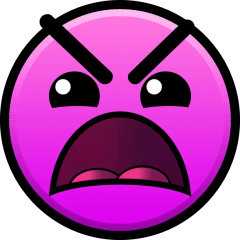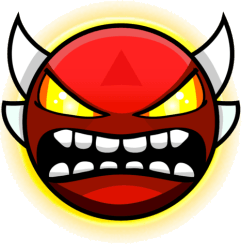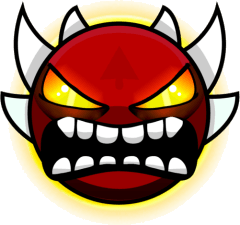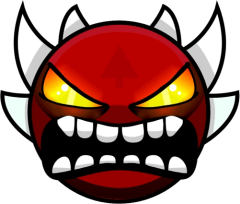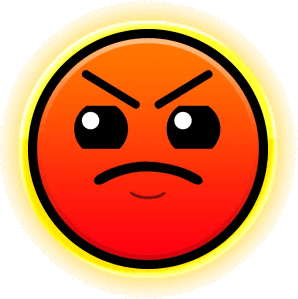Moderator
Rating Curve
Filters
Reviews
I do appreciate good atmosphere creation in levels, and cloudnine has a lot of that. I like the juxtaposition of the calmer first half of the song with the foggy, blended particles and gentle flashing effects as it creates a somewhat dreamlike environment that goes nicely with the lower energy song. This is helped by the large, oddly shaped floating structures, and the slight bouncing movement on them makes them feel like they're floating in space, which is a good touch and adds to the dreamy atmosphere further.
The second half of the level changes approach to a much cleaner, almost Frums-like visual overlay and flashier, higher-energy colour and effect work, to compensate for the song's increased energy. While I think this looks very good, and the playback bar in particular near the end is a standout visual that really works in the part's favour to build a strong identity, there's really no correllation between the two halves of the level beyond colour. The design style, while simple, completely shifts from the first part's muted colours and invisible block patterns to the second half's flat coloured spikes with no transitionary period, which is jarring and not particularly called for since the song's synths and melodies remain quite similar.
The gameplay is communicated to the player quite clearly, as all of the structures use very distinct outline colours (usually rainbow offset about 90 degrees from the rest of the level) that separate them from the background successfully, so despite the aforementioned issues I think this is quite a solid level. I would love to see more work done incorporating a strong, consistent theme into the level as a whole, while also leaving room for each part to maintain its own visual identity as they do now. I would recommend this level for Star Rate.
GabberFly has the fundamentals of 1.9 design down quite well in all regards. I appreciate that each part individually has its own defined structuring style, as it gives each part a much stronger identity and keeps the level as a whole feeling varied. For example, the 45 degree sloped structures in the UFO around midway through are a visual standout as this kind of structure was not as popular back in 1.9, but also serves to create some fairly interesting gameplay as the slopes nearly match the natural gravity of the UFO gameplay, placed at odd positions and using gravity portals to add a memorisation element without the need for fakes or invisible gameplay.
Most of the block designs follow the same general template, with a darker "outline" of one type of block (generally brick, flower or metal blocks), and a lighter inner section that tends to pulse more strongly and contain more detail. This template on its own is quite solid, and the contrast it creates between the two main design layers is very nice, but I would have liked to see more variation on it throughout the level. Mixing the outline colours with the inner section, swapping designs, or even having everything on one design might have helped certain parts stand out more - namely the wave-cube dual at 0:35 where the colouring across all of the elements is similar enough that the contrast factor is minimised, leaving the designs as a whole quite messy. Aside from this, though, the level is solid in most aspects, and I'm quite surprised this was never rated. Nowadays I would recommend it for Star Rate.
There's a lot of unbridled "early 2.1 art level" energy going on in Revelations, and in that aspect it's quite solid. The art quality is rough at times, with many of the assets having small visual errors, inconsistent outlines or otherwise very obvious usage of certain default blocks for texturing (namely the bricks near the beginning), but personally this is something I enjoy and find quite nostalgic. I like when levels take creative liberties to recreate real life without leaning on blending, alpha or other similar mechanics to create smoother, cleaner art as is more common nowadays.
I couldn't tell you much about this level's overall theming, which is a big point of criticism I have. When your level is so art-centric as to necessitate nearly every aspect of it being geared around a singular aesthetic or inspirational setting, as Revelations' individual parts are, I think a pretty strong overarching theme or stylistic correlation is required to create a cohesive final product. More traditional styles like design generally do this by way of specific habits creators will fall into with their works, like structuring shape, usage of specific blocks or textures for details (think Namtar's late 2.0-early 2.1 works), or even how they use negative space to highlight their designs like someone like Chase97 would with his comparatively simpler backgrounds and very complex, angular block designs. This is extremely hard to pull off in an art level without a cohesive theme, and in the case of Revelations each part's ideas are pretty much completely different (a castle placed next to what seems to be the inside of a creature's stomach chronologically, with no real transition between them), leaving little part-to-part connection. (edited)
With that said, I will commend xGDFUNx for integrating intuitive structuring into their art. Every part's hazards are set up in such a way that their nature is quite obvious to the player, which is relatively uncommon in these kinds of full art levels. My favourite example of this is the long, waving neon green tendrils towards the end, s they mesh very nicely with the acidic theming while also standing out as being hazards in both colour and shape. This makes the level quite enjoyable to play, so despite the aforementioned flaws I would personally recommend it for Feature. There's tons of potential for this creator to further explore art-based levels, and I look forward to seeing more of them in the future.
This is another case of an older level remake that completely misses the mark for me. Thinking Space's gameplay always fascinated me because of how creative it was - the cube memory maze was unlike anything I'd ever seen back in 2020, the moving wave is absolutely legendary for being unbelievably hard to both learn and play due to it being so inconsistent, and generally the level just pulls no punches to try and be as difficult as possible. Not only is Thinking Space II's gameplay unfaithful in the sense that it doesn't stick to the same philosophy and 2.0 object usage, any "fun" factor is completely removed as the level is now so hard as to be borderline unfair to the player. Additionally, while the decoration itself is okay and I don't have much to say about it, I don't think it fits a Thinking Space remake at all. It's much too polished for the very rough, weirdly structured gameplay the level has - the angular designs are often crammed into odd shapes to compensate, there's often either too much or too little negative space (particularly in the second half), and while the space theming does do its job, it's really just not enough to carry the level. I really wish the team behind this level chose to be more faithful to the original in terms of visuals, as I feel there's tons to be explored with that sort of janky, messy 2.0 style, even in black and white.
I'm not secretive about disliking most "Nine Circles" levels as I feel the concept has been used and reused into the ground - it's rare to see a level do something unique in the genre, but Mujigae manages it to a surprising degree. I like Mujigae's approach to lean fully into its very saturated rainbow colours, doing away with flashing the structures like a typical NC level and rather having the colours pulse from outside to inside. This approach allows YGYoshI to play around with blending far more than otherwise, letting the foreground and background almost meld together into a flashy mess, while the slightly disconnected pulse timings created by the aforementioned effect contrast just enough to let the player know where the structures are. This is not only very unique, but also creates a lot of interesting textures where the negative space in between the structure blocks overlaps with the background designs (namely in the second part of the drop, the background circles giving the blank spots the look of a sideways pulsing effect that doesn't exist).
This is ultimately a more specific example of the main thing I enjoy about Mujigae; it goes against the general conventions of most NC levels in almost every aspect. The song is much brighter and happier (and less bassy) than the gritty dubstep used in the most famous levels of the genre, which gives an implicit reason for the exceedingly bright rainbow colours by way of association, as at least in my mind I associate rainbow levels like this with the whimsical and joyous far more than with something like dubstep. The typical cube-ship-ball-wave-cube gamemode progression is also done away with completely, with the predrop using every single gamemode except for wave.
This is where my praise ends, though, as there's very little overall cohesion to these parts aside from colour scheme. The usage of the gamemodes themselves is underwhelming, often throwing many gamemode portals into one part with no change in gameplay/visual style or the song. I would have liked more usage of each gamemode and its unique mechanics and physics to be worked into the part's ideas; the one part of the predrop that I feel does this quite well is the UFO, where the clouds and floating structures feel right at home with where a UFO would intuitively find itself. The designs in these parts are quite basic, and don't make good use of the blending like the drop does, with the bright backgrounds frequently washing away important details in the structures rather than adding to them, namely the ball section close to the drop. This leaves the non-drop parts without any real identity beyond their colour scheme, which is just disappointing when there's so much more to this level and its ideas than just a "rainbow nine circles level". I only wish YGYoshI ran with that more when making the level, because otherwise this is one of the best Nine Circles levels to date.
To start off, I'd really like to point out just how ahead of their time Optical's designs in the first and last part are. The two-layered, unusually shaped structures are simple, but quite visually striking because of the contrast between the "roof" of the 2.0 fake 3D blocks and the "interior" of the glass effect blocks. That sort of contrast goes such a long way towards elevating simple designs, and this is on full display here considering how slow both of these parts are. Haru's parts all reuse this square with layered blending glow in different ways - in the UFO, subtle pulsing makes the saws feel like they're shining in time to the song, which highlights them against the dark background quite nicely. In the ship halfway through the level, the pulses make the squares feel like they're expanding in time to the song's percussion because of the way their saturation gets blown out, which is quite a technically impressive effect to pull off for 1.9 and looks very nice. Lastly, the shining effect is redone in the final ship, without any sawblades this time and simply as air decoration. I don't think this is as effective, but it still looks pretty nice and works well enough as a negative space filler such that the part doesn't feel like it's missing anything.
One specific thing I'd like to touch on are the crystals in the ball part around 27%. While these aren't anything new, I love the usage of pulsing different groups of crystals in time to the music. It feels like light is flashing or refracting off of them, helped by the little glow stars placed over some of the bigger crystals, and it's a surprisingly convincing effect considering only 4 groups of crystals are used and their individual designs barely change, just their positioning and angle. I do think the claustrophobic gameplay is a big contributing factor here, as making the part feel more cavelike helps sell the illusion better. This is my favourite example of Haru and Optical's technical prowess in the editor in Reinstall, but the whole level shows a ton of skill on both creator's parts, and results in quite an enjoyale final product.
COME TO DADDY's theming is near immaculate. An uncommon, much darker and energetic song from Aphex Twin opens a world of possibilities for theming, but skywalker14 takes a fairly literal approach that just feels like hell. The dominant colour of everything is dark red, and the level's backgrounds are all mechanical or city-like (somewhat reminiscent of Ultrakill), but I really like how this is twisted into a more humanoid form for many of the foreground designs. The repeating motif of arms present throughout the level goes such a long way to drawing out this constant connection between the human form and the level's hellish nature, which when combined with the screaming, distorted vocals and guitars of the song does a fantastic job at making the whole level feel like humanity's purgatory. Based on the music video bearing a fair resemblance to this concept, I think it's safe to say skywalker14 executed the song's vision nearly to perfection in this regard.
The more mechanical elements of this level are no slouch visually, either, but what I think really makes it is how skywalker14 blurs the lines between the two at various points. The choice to taint many of the level's more mechanical foreground elements with visible blood (namely, the spikes in the first part, and the saws and green skyscraper-like blocks in the drop) ties the two major themes of the level together quite nicely, although I really wish this was done more often as it is very easy to miss. Having the structures glitch into more humanoid shapes would have been a good way of doing this - a glitching effect was already shown off in the second part that would have been perfectly suited for this purpose. The mechanical faces in the background of the drop that appear to scream the song's lyrics are a much better application of this concept, in my opinion, as both elements of the level are already invariably tied to them in concept, blending together humanoid and mechanical elements into this giant abomination that really sells how hellish the level feels. Either way, COME TO DADDY is a fantastic thematic exploration of Aphex Twin's music, with so much depth despite its short runtime, and despite the flaws in execution it has.
Ideal has a very interesting visual style, mixing complex, angular designs with quite a unique structuring style and gameplay that is utterly invisible at points. I don't know whether this was intentional, but the foregrounds and backgrounds both comprise of very similar designs and are usually almost the same colour, so there's little separation between the two and they blend together frequently. Darkening the backgrounds further and/or hue shifting them about 45 degrees would have fixed this issue and significantly improved the playability. With that said, the designs themselves are solid, and remind me a lot of SleyGD's older projects. I like the usage of slopes to fill in the corners of most of the designs, and the diamond objects used to create little pillars on the left and right sides of the main structures are also a very aesthetically pleasing touch. The square blocks capped with a small rectangular "roof" of sorts with the tapered edges is a pretty good look, and the wavy designs of the roof do help differentiate from the mostly right-angled interior structure designs, but I would have liked the base colour of the roof to be a bit lighter to help this further.
The main structures are usually connected to another smaller one by way of the aforementioned roof blocks, with the smaller structure generally being a solid 1x2 or 2x2 block rather than the hollow 3x3 one used for the main structures. This is quite a creative use of the multi-layered designs, and in isolation I really like how it's executed here. However, I can't overlook the fact that it does not change at all throughout the entire level (neither do the designs or backgrounds, although the colours do). The whole level is really just one concept done over and over again until the creator was happy with its length. This makes the whole thing feel very monotonous, and I'd probably recommend it for Star Rate because of this, but Ideal is still a solid project from a creator I've never heard of.
Whether this is a new project or old ones from back in 2014 or so when Rublock5 was an active creator, Rapid System is a nice little callback to the "good old days" of Geometry Dash. Even for the time it was likely made (1.8 or 1.9), it's quite simple and draws pretty heavy inspiration from Theory of Everything 2, using large chunks of small invisible squares, vertical blending glow pillars and lots of other timely decoration choices. I don't have too much to comment on here due to how simple this level is, but I do appreciate how concise each part feels. Every part has its own defined idea or stylistic choice that it centers around - the aforementioned invisible square structures guide the player through a gravity portal corridor with a ship, one part uses many identical vertical 3x1 blocks to form a little staircase for the cube, and another uses slanted pillars to direct the ship between some spiked structures. The level as a whole flows nicely from one part to the next, and quite a high level of understanding of general design criteria is shown for the time. This is a pretty impressive project for the time it was (likely) made in, and I do hope it receives a Star Rate. Nice work!
BOOBAWAMBA lands itself in a weird spot due to its difficulty contrasting with its visual style in a very odd way. Visually, this level reminds me a lot of Alika by 2003Devin, with flat, angular and mechanical designs comprising mostly of flat outlines and clunky movements. I'm a huge sucker for this aesthetic, and it's pulled off really well in this level in large part due to the highly detailed, moving backgrounds that feel like the inside of a labyrinthine factory. I'm especially a fan of the fact that the background layers are the same as the foreground layers, which further sells the absolute size of the environment.
I can't speak on the gameplay as this level is WAY too hard for me to play, but at least visually it interacts with the memory elements very well. In particular, the parts where the player holds a light are excellent due to the heavy use of decoration above the player. The huge, shadowy structures offset the light's added visibility and make the parts feel surprisingly claustrophobic. The structures are also sometimes layered in a way where they are only visible outside of the main beam of light, which is a very nice memory tactic and keeps the player on their toes, only catching glimpses of some of the level's dangers.
With that said, to me this level just doesn't feel like a top demon. The defining quality of a lot of the hardest levels in the game is how intimidating they are; whether from raw difficulty like Tidal Wave, intimidating music and visuals of death or otherwise deadly hazards like Slaughterhouse and Arcturus, or pure claustrophobia like qoUEO or Menace. For me, this is a huge part of what makes these brutally difficult levels work, as the choice to make a level so hard as to be permanently unbeatable for 99.9% of the player base should have some intrinsic justification to make it stand as something that intimidates the hell out of anyone brave enough to try to beat it.
Some shreds of this are present in BOOBAWAMBA, with the shifting, claustrophobic factory sections definitely bringing out that sense of intimidation for me. The parts that hide their raw difficulty, however, do the exact opposite of this by completely obfuscating their difficulty, with no real support from the visuals (which tend to just be fog or ominous shadow) or the song. This is mostly apparent in the second half, where the gameplay is barely visible and the song is quite calm. There's a big disconnect between this level's difficulty and how hard it "feels" intuitively, at least for me, and while I can't speak on how this translates to its actual difficulty, it leaves the level feeling disconnected from its own vision.
There's tons of potential for difficult memory levels to succeed - just look at how LIMBO is viewed today or how KILLBOT was viewed upon its verification. It's all about synchronising all of the level's elements to really invest the player or viewer into the level and its difficulty. BOOBAWAMBA does a lot of things right, but really fails at this one crucial point, and I hope in the future somebody does succeed at it.
GDPR Cookie Consent
Hyperbolus uses cookies and local browser storage to enable basic functionality of the site. If we make any changes to these options we will ask for your consent again.
sorry about this gang
